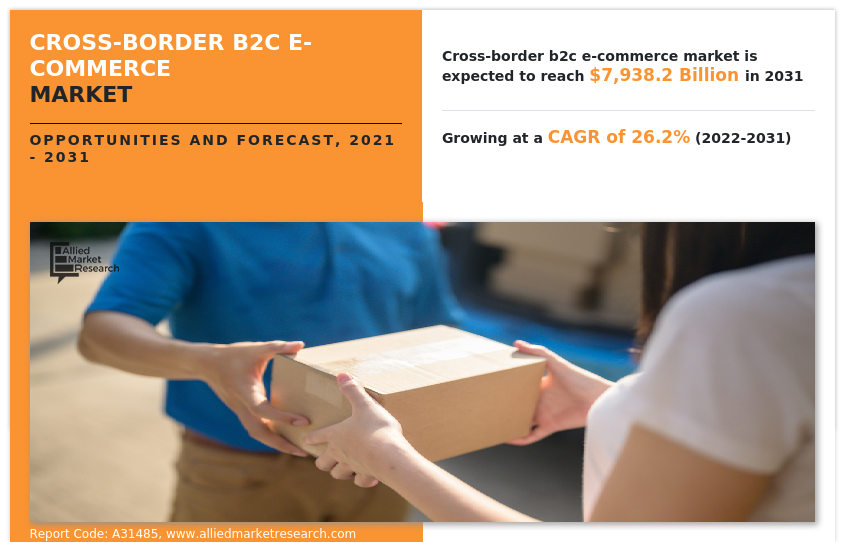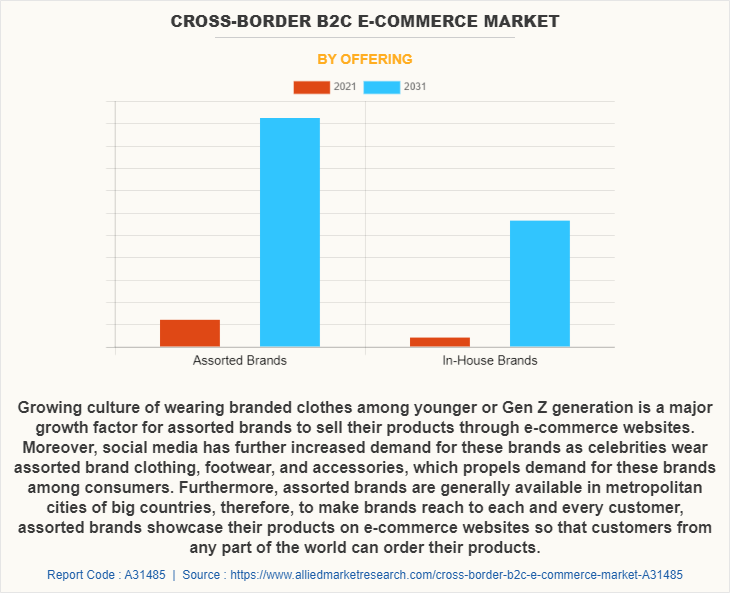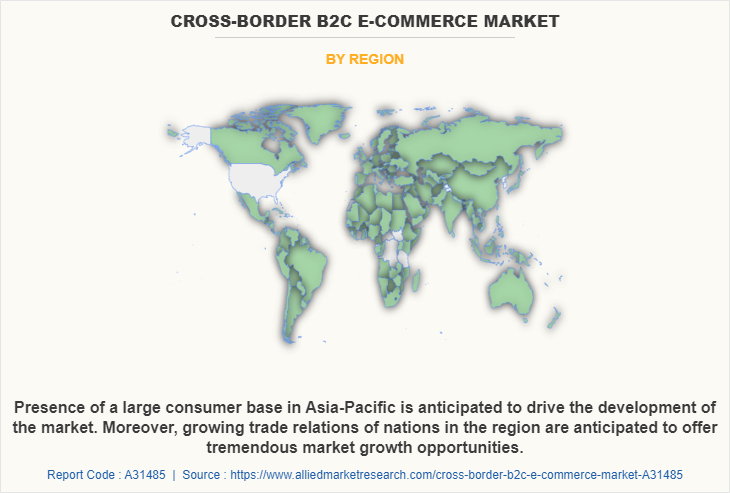Cross-Border B2C E-Commerce Market Research, 2031
The Global Cross-Border B2C E-commerce Market was valued at $784.6 billion in 2021, and is projected to reach $7938.2 billion by 2031, growing at a CAGR of 26.2% from 2022 to 2031.
Cross-border B2C e-commerce is the process of selling products or services across borders on an electronic platform. Unlike the physical retail industry, e-commerce can access new and growing markets with relatively minimal investments. Moreover, by penetrating into international markets in different climates and seasons, sellers can enjoy consistent demand throughout the year. Businesses that sell in the same country often get confined to the same season, climate, and occasions. However, when they sell to an international market, they get to take advantage of peaks in demand for their product all year round. The business benefits from the seasonal surges that occur at different times of the year in different countries and their weather conditions.

Cross-border B2C E-commerce helps both the buyer and seller to increase their market reach as consumers have more purchase options at good price and simultaneously the seller has a big consumer reach. Therefore, this is one of the major driving factors for the market. In addition, cross-border B2C e-commerce helps to increase sales and revenue for e-commerce websites, as they get international traffic in their websites which helps them to make their brand visible. Moreover, with the increase in smartphone users and the penetration of internet, it has become easier for both the business and consumers to locate each other in order to buy and sell products through e-commerce websites. Therefore, these are some of the major factors propelling the growth of cross-border B2C E-commerce market.
However, in case of a cross border b2c e commerce purchase, sellers charges a hefty amount for delivering the product to the customer, since it involves various taxes, which increases the overall cost of the product. Therefore, this is a major drawback for the cross-border B2C E-commerce market growth. Furthermore, there are high chances of receiving faulty or damaged products, and if this situation arises, then it is very difficult for the customer to return back the product to seller. Thus, this are some of the major restraints in the cross-border B2C E-commerce market. On the contrary, growing trade relations among various countries and improvement in the cross border ecommerce channels for transportation of products from one country to another, along with government support for execution of trade among countries is expected to provide lucrative growth opportunities for the market in the coming years.
The report focuses on growth prospects, restraints, and trends of the cross-border B2C E-Commerce market analysis. The study provides Porter’s five forces analysis to understand the impact of various factors, such as bargaining power of suppliers, competitive intensity of competitors, threat of new entrants, threat of substitutes, and bargaining power of buyers, on the cross-border B2C E-commerce industry.
The cross-border b2c e-commerce market is segmented into Category, End User, Offering and Payment Method.
Segment Review
The cross-border B2C E-commerce market is segmented on the basis of offering, payment method, category, end user, and region. By offering, it is segmented into assorted brands and in-house brands. By payment method, it is bifurcated into credit/debit cards, digital wallets, internet banking, and others. By category, it is segregated into apparel and accessories, personal care & beauty, entertainment & education, healthcare & nutrition, foods & beverages, and others. On the basis of end user, it is divided into adults, teenagers/millennials, senior citizens, and others. By region, the market is analyzed across North America, Europe, Asia-Pacific, and LAMEA.

By offering, the assorted brands segment attained the highest growth in 2021. This was attributed to the growing culture of wearing branded clothes among the younger or Gen Z generation. Moreover, social media has further increased demand for these brands as celebrities wear assorted brand clothing, footwear, and accessories, which propels demand for these brands among consumers as they follow their favorite celebrity or social media influencers and get inspired by them to purchase these brands.

Region wise, Asia-Pacific attained the highest growth in 2021. This is attributed to the presence of a large consumer base in the Asia-Pacific is anticipated to drive the development of the market. Moreover, the growing trade relations of nations in the region are anticipated to offer tremendous market growth opportunities.
The report analyzes the profiles of key players operating in the cross-border B2C E-Commerce industry such as Alibaba Group Holding Limited, Anchanto Pte. Ltd., BoxMe, Deutsche Post DHL Group, Fruugo.com Ltd., Joybuy.com, SIA Joom, Paypal, pinduoduo.com, and Shein. These players have adopted various strategies to increase their market penetration and strengthen their position in the cross-border B2C E-Commerce market share.
COVID-19 Impact Analysis
The COVID-19 had a negative impact on the cross-border B2C E-commerce market outlook as international trade came to a standstill during the lockdown period. In addition, transportation of E-commerce products from one country to another was stopped as international borders were closed which affected the market negatively. However, as the lockdown restrictions were uplifted, there was a surge in the demand for B2C E-commerce products, as a large number of sellers adopted online channels to sell their products online to international customers. Moreover, as the trade relations among countries are improving and cross border channels are developing such as airways, sea transport and roadways, the demand for cross-border B2C E-commerce market size is subjected to grow, as COVID-19 played a major role in popularizing online sales of products via E-commerce websites and international sellers have huge opportunity to tap into other countries to sell their products.
Top Impacting Factors
Cross-border B2C E-Commerce helps to Expand Market Reach for Buyers and Sellers
Cross border ecommerce presents a whole new market for both the buyers and sellers. Online trade between B2C have a large options of products and brands to choose from, which is not available in their own country, thus expanding their purchase options. Whereas, the sellers gets a large customer base to sell their products, thus expanding their market reach to international customers. Moreover, with the help of cross-border B2C E-commerce, various brands can sell their products to different counties even if they do not have a physical store in those countries. This in turn increases the brand visibility of the product as large number of customers get to know about the brand and use their product. In addition, the customers get a chance to try new products, brands at a good price. Therefore, this is a major driving factor for the the cross-border B2C E-commerce market growth.
Chances of Receiving Faulty Products
The chances of receiving faulty or damaged products when ordering from cross border E-commerce websites are higher, as the product is shipped from one country to another, the products may get damaged while in transit due to mishandling as the delivery route is longer. Moreover, consumers mostly buy fragile products such as crockery, paintings, glassware and others from international sellers as they are famous for their products. However, the fear in the minds of customers about receiving the product in a broken condition discourages them to make such purchases. In addition, if the product is received in a damaged condition, it is a very time taking and costly process for the customer to return the product, as the seller may reject to return request, or it may take a lot of time for the product to reach the seller, and it also involves huge cost to return the product back, which the customer has to pay out of their pocket. Therefore, this factor limits the growth of the cross-border b2c e commerce market.
Growth in Cross-border Trading
Major economies are making trade relations and signing agreements on executing cross-border trade with each other. In addition, countries are allowing other countries to sell their products in their countries thereby increasing trade. Furthermore, the government bodies are also playing a major role in developing their cross border trade routes with other countries, so that transportation of goods can improve. Development of new sea ports, airways, and improvement of road infrastructure will collectively contribute towards the growth of cross border trades among various countries. Therefore, improving trade relations along with government support and developing infrastructure will provide major lucrative opportunities for the growth of the cross-border B2C E-commerce market in the upcoming years.
Key Benefits for Stakeholders
- This report provides a quantitative analysis of the market segments, current trends, estimations, and dynamics of the cross-border B2C E-Commerce market analysis from 2021 to 2031 to identify the prevailing cross-border B2C E-Commerce market opportunity.
- The market research is offered along with information related to key drivers, restraints, and opportunities.
- Porter's five forces analysis highlights the potency of buyers and suppliers to enable stakeholders make profit-oriented business decisions and strengthen their supplier-buyer network.
- In-depth analysis of the cross-border B2C E-Commerce market forecast assists to determine the prevailing market opportunities.
- Major countries in each region are mapped according to their revenue contribution to the global market.
- Market player positioning facilitates benchmarking and provides a clear understanding of the present position of the market players.
- The report includes the analysis of the regional as well as global cross-border B2C E-Commerce market trends, key players, market segments, application areas, and market growth strategies.
Cross-Border B2C E-Commerce Market Report Highlights
| Aspects | Details |
| Market Size By 2031 | USD 7938.2 billion |
| Growth Rate | CAGR of 26.2% |
| Forecast period | 2021 - 2031 |
| Report Pages | 323 |
| By Category |
|
| By End User |
|
| By Offering |
|
| By Payment Method |
|
| By Region |
|
| Key Market Players | Alibaba Group, Anchanto, Fruugo, DHL Group, BoxMe, Joom, JD.com (JingDong), Shein, Paypal, Pinduoduo |
Analyst Review
Cross border B2C E-commerce is the process of selling products or services online across geopolitical borders to customers in foreign countries. Compared to local ecommerce in which a retailer only sells within its country of origin, global ecommerce allows merchants to expand into non-native markets and reach new customers. With so many ecommerce platforms, marketplaces and digital solutions available, there are practically no limits for merchants looking to sell online, which makes it easier than ever for businesses to go global. Although the coronavirus pandemic posed some challenges for the cross-border E-commerce market, according to eMarketer, global retail ecommerce sales experienced a 27.6% growth rate in 2020, with sales reaching well over $4 trillion. Furthermore, in a survey of 33,594 consumers across 40 countries conducted by the International Post Corporation in March 2021, 32% said they made more online purchases in 2020 from retailers in foreign countries, owing to the pandemic and 51% plan to do more cross-border online shopping in the future.
Furthermore, market players are adopting various strategies for enhancing their services in the market and improving customer satisfaction. For instance, in January 2022, Shopify, a Canadian multinational e-commerce company, and JD.com, a Chinese e-commerce company, collaborated to reduce the barriers in international trade by allowing merchants to list their products on JD’s cross-border e-commerce platform, JD Worldwide. The new sales channel opens access to JD’s 550 million active customers in China. In addition, the channel accelerates the process by assisting with onboarding, managing end-to-end fulfillment from JD’s U.S. warehouses directly to consumers in China, and leveraging JD.com’s China-U.S. cargo flights, 1,300-plus warehouses, and 200,000-plus delivery personnel in China. JD Marketplace also provides price conversions, taking into account foreign exchange rates and taxes, as well as assisting with translating product names and descriptions. Therefore, these strategies will provide major lucrative opportunities for growth of the market in the upcoming years.
Some of the key players profiled in the report include Alibaba Group Holding Limited, Anchanto Pte. Ltd., BoxMe, Deutsche Post DHL Group, Fruugo.com Ltd., Joybuy.com, SIA Joom, Paypal, pinduoduo.com, and Shein. These players have adopted various strategies to increase their market penetration and strengthen their position in the industry.
the Cross-Border B2C E-Commerce Market will expand at a CAGR of 26.2% from 2021 - 2031
the market value of Cross-Border B2C E-Commerce Market by the end of 2031 will be $7,938.18 billion
Cross-border B2C E-commerce helps both the buyer and seller to increase their market reach as consumers have more purchase options at good price and simultaneously the seller has a big consumer reach. Therefore, this is one of the major driving factors for the market. In addition, cross-border B2C e-commerce helps to increase sales and revenue for e-commerce websites, as they get international traffic in their websites which helps them to make their brand visible. Moreover, with the increase in smartphone users and the penetration of internet, it has become easier for both the business and consumers to locate each other in order to buy and sell products through e-commerce websites. Therefore, these are some of the major factors propelling the growth of cross-border B2C E-commerce market.
The report analyzes the profiles of key players operating in the cross-border B2C E-Commerce industry such as Alibaba Group Holding Limited, Anchanto Pte. Ltd., BoxMe, Deutsche Post DHL Group, Fruugo.com Ltd., Joybuy.com, SIA Joom, Paypal, pinduoduo.com, and Shein.
The cross-border B2C E-commerce market is segmented on the basis of offering, payment method, category, end user, and region. By offering, it is segmented into assorted brands and in-house brands. By payment method, it is bifurcated into credit/debit cards, digital wallets, internet banking, and others. By category, it is segregated into apparel and accessories, personal care & beauty, entertainment & education, healthcare & nutrition, foods & beverages, and others. On the basis of end user, it is divided into adults, teenagers/millennials, senior citizens, and others. By region, the market is analyzed across North America, Europe, Asia-Pacific, and LAMEA.
Loading Table Of Content...



